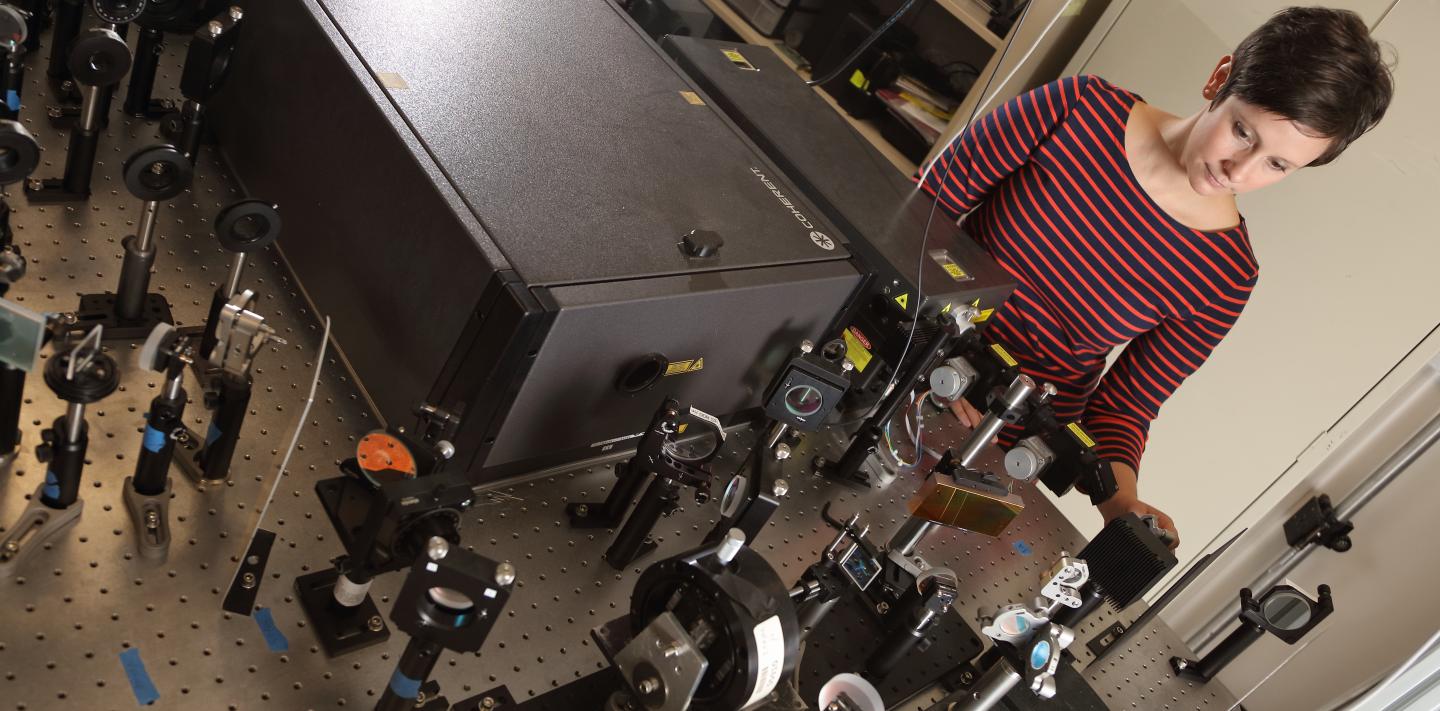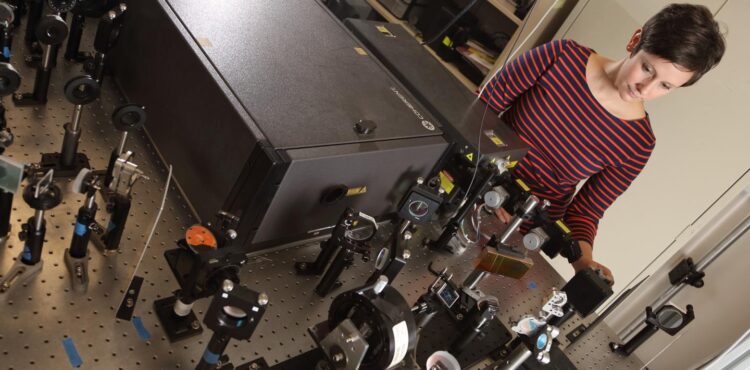Rising star and mechanical engineer Chloe Dedic is measuring the elusive qualities of flame to inform hypersonic engine design

Credit: Tom Cogill for UVA Engineering
An “air-breathing” hypersonic engine is elegant in its simplicity.
While propelling a vehicle at five times the speed of sound or faster, the engine sucks in and traps oxygen from the earth’s atmosphere, then reduces the air to supersonic speed, compresses it, and uses it to feed combustion.
Unfortunately, this type of engine has one Achilles’ heel: After one, fairly short hypersonic flight, the engine typically is ruined by the intense heat from the air velocity and the combustion process.
Studying combustion, especially in a supersonic environment, is a way to start solving this problem.
Chloe Dedic, an assistant professor in the University of Virginia’s Department of Mechanical and Aerospace Engineering, is using an advanced technique that will capture a snapshot of the gas-phase combustion reactions in the Mach 5 conditions created at a UVA test facility.
Dedic has been recognized as a “rising star” by the Defense Advanced Research Projects Agency and has recently been awarded the highly competitive 2020 DARPA Young Faculty Award to support this research. She is one of three UVA Engineering faculty to receive the award this year. Federal agencies are interested in hypersonic technology as a national security issue, in part because of recent advances reported by Russia and China.
The insight provided by Dedic’s project will contribute to the development of air-breathing hypersonic engines so they might become durable and efficient enough to fly longer distances and be re-used — a pretty big leap from where the technology is now. The information that Dedic is gathering is expected to provide better data for design simulations.
“I am excited to be working on this project,” Dedic said. “These measurements will offer a new level of granularity and amount of information previously unavailable experimentally.”
Dedic’s techniques could also be used in simulations of vehicles entering the Earth’s atmosphere. Getting better insight into the tremendous heat and material stress on the vehicles could help improve the design of thermal protection systems.
How do you measure gases that are as thin and fast-moving as a phantom? How do you get inside a combustion process without destroying your measurement tools? Dedic is using a state-of-the-art laser technique called “ultrafast coherent anti-Stokes Raman scattering,” or CARS, which can pinpoint the gases and chemicals in a flame. Precise measurements of a flame’s properties can reveal ways to improve combustion efficiency and stability.
Lasers are renowned for their incredible focus and resolution, and Dedic’s technique significantly increases measurement resolution compared to previous capabilities.
“I am excited to be able to observe and probe chemical reactions and flow dynamics while they are occurring,” she said. “We can get a snapshot of gas molecules at a single instant in time and extract information to provide an ‘engineering measurement’ useful for understanding aerospace systems.”
Documenting the minute details of fuel, air and temperature over time will create an unprecedented understanding of combustion.
“A lot of things are going on in different parts of the engine at once,” Dedic said. “Air and fuel mixing, extreme temperatures, heat transfer to the walls, high speed flow, turbulence and chemical reactions. We aim to gain critical insight into what happens during the combustion process by measuring multiple variables in the same location and at the same instant in time. So far, this type of complete, simultaneous data within this test environment is not yet available.”
“Chloe is one of a handful of people in the world who have mastered this CARS technique. She mixes three wavelengths of colors to a point that is as thin as a human hair, 50 microns, that are in phase together at the same point — it’s not a trivial task. Molecules in that local point signal a response so we can extract the composition and know what’s happening,” said Harsha Chelliah, professor of mechanical and aerospace engineering and director of the UVA Reacting Flow Lab, with which Dedic is affiliated. Dedic and Chelliah are part of the UVA Hypersonic Research Complex, and Chelliah serves as director of the National Science Foundation’s combustion and fire systems program.
“The multi-variable data gathered from this process about the state of the reacting gases offers an improvement over other measurement techniques used in the past,” Dedic said. Data is typically collected with wall-mounted sensors, line-of-sight optical measurements, or sampling the engine exhaust and assembling clues to determine what happened.
Dedic is also interested in understanding how the high-temperature reactive gas located within the engine or at the leading edge of hypersonic vehicles can interact with walls and surfaces–potentially leading to damage or system failure. She’s planning to use similar measurement techniques to quantify such gas environments using test facilities that can simulate atmospheric entry conditions.
Studying the different types of gases and temperature near surfaces will help develop future materials and aircraft designs and help prevent the engine or aircraft from burning up.
In addition to Dedic’s laser diagnostic expertise, a key factor in her ability to obtain the critical data she seeks is the UVA Supersonic Combustion Facility, the only one of its kind in the world. The facility can simulate Mach 5 hypersonic flight conditions for several hours at a time, while other facilities typically test similar conditions in short bursts. Dedic is able to gather more comprehensive data with the longer test time. The UVA facility also uses electrically heated air, which means the test air is not contaminated with the products of combustion that are often present in combustion-heated facilities, and therefore offers the most realistic gas environment.
“Having access to such a unique and powerful experimental facility at UVA is critical to the success of this research, and really enables the type of quantitative measurements we want to make,” Dedic said.
The combustion tunnel was originally designed and constructed by professor emeritus James C. McDaniel of the UVA Department of Mechanical and Aerospace Engineering and has been employed for laser-based measurement campaigns by other faculty including UVA’s associate professor Chris Goyne and Chelliah, and professor Andrew Cutler from the George Washington University School of Engineering and Applied Science.
Cutler has experience in using similar advanced, laser-based measurement systems at the UVA Supersonic Combustion Facility and will assist Dedic on the facility tests for this project. Cutler is a long-time collaborator with the UVA Department of Mechanical and Aerospace Engineering dating back to the UVA Center for Hypersonic Combined Cycle Propulsion, launched in 2009 and supported by a five-year $9 million grant from NASA and the Air Force Office of Scientific Research.
Cutler said he thinks Dedic’s project will be a game-changer.
“The combustion environment within a hypersonic engine is one of extremes,” he said. “A byproduct of these extremes is that, while the regions occupied by flames may be extensive, the flames themselves are thin and convoluted. For the scientists and engineers that seek to understand these flames by probing them experimentally, this presents great difficulties. Professor Dedic is pioneering efforts that employ very short pulse length lasers to probe these flows at smaller scales than ever before in an effort to better understand them. New insights will guide the computationalists and mathematicians that are creating the next generation of simulation tools.”
###
Media Contact
Wende Whitman
[email protected]
Original Source
https:/





